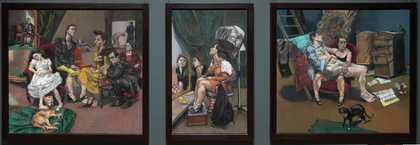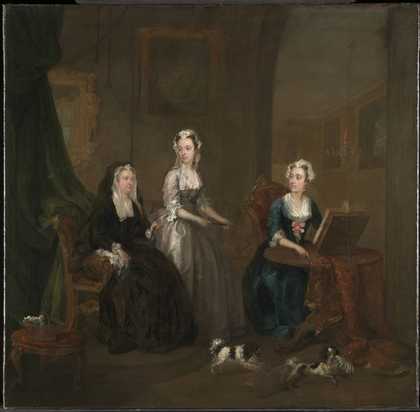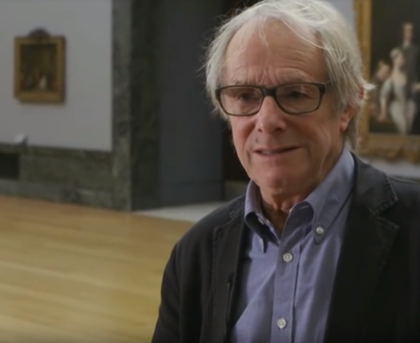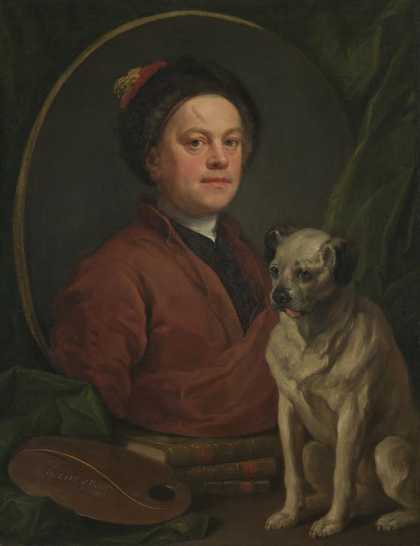
William Hogarth
The Painter and his Pug (1745)
Tate
The eighteenth-century artist William Hogarth is best known for his satiricial and sometimes scandalous depictions of London life. Here are five things to know about one of England's most celebrated artists.
Hogarth and his contemporaries lived in a rapidly changing world
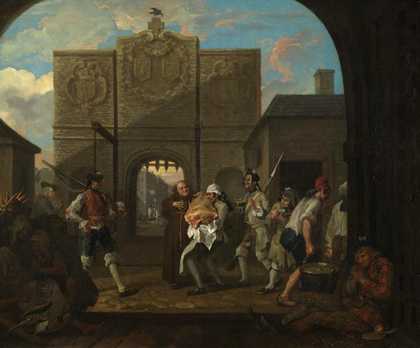
William Hogarth
O the Roast Beef of Old England (ãThe Gate of Calaisã) (1748)
Tate
In the mid-1700s, following a century of conflict and war, Europe entered a period of relative peace and stability which brought economic prosperity and new opportunities. Artists became less reliant on money from the church, state and aristocracy. This gave them greater freedom to comment, to choose their subject matter and to address audiences directly.
Alongside a depiction of contemporary tastes and modern life in London, William Hogarthãs paintings reveal stark inequalities around class, race and gender. Simultaneously artists across Europe were painting parallel portraits in cities such as Paris, Venice and Amsterdam.
Yet, the depth of inequality is also evident in the way Hogarth falls into xenophobic tropes. This is clear in The Gate of Calais (1748) where Hogarth satirises the fussiness of French cuisine by showing starving Frenchman coveting a large joint of British beef, during a time of widespread food shortages (particularly meat) in France. Also mocked are a Jacobite, likely exiled to France during the Jacobite rising of 1745, who subsists on raw onion and a crust of bread, and Franceãs devotion to the Roman Catholic church, with a greedy priest ãblessingã the beef joint by running his fat finger along it.
Hogarthãs use of contemporary stereotypes suggests how entrenched ideas of national loyalty and identity were at the time.
He had a wicked sense of humour

William Hogarth
Gin Lane (1751)
Tate
Humour is an important feature throughout Hogarthãs work. Gin Lane (1751) and Beer Street (1751) are a pair of prints created as propaganda in support of the new Gin Act. This law attempted to curb excessive gin-drinking by introducing a new tax on spirits.
While Beer Street is a jovial and prosperous scene, its contrasting pair reveals an array of gin-fuelled disasters, including a woman who is too drunk to even notice her falling son. Although a tragic scene, there is a dark comedy in the absurdity of the childãs open-mouthed shock as he plummets to his death.
Hogarthãs series have distinct moral lessons
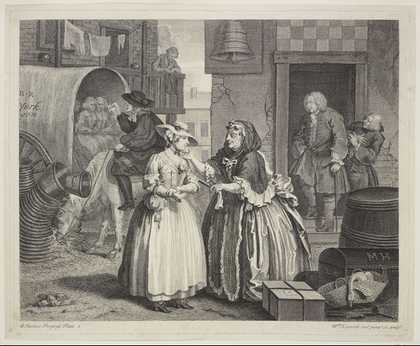
William Hogarth from A Harlot's Progress 1733 Royal Collection Trust / ôˋ Her Majesty Queen Elizabeth II 2021
Hogarthãs moralising is evident in A Harlotãs Progress (1732), which tells the story of Moll Hackabout, a young woman who arrives in London and is immediately seduced into sex work.
In the first scene in the series, Moll carries scissors and a pincushion, suggesting she planned to work as a seamstress. Instead, upon moving to the city, she becomes another neglected casualty in commercial society, leading to her decline in fortunes and eventual death. In the final scene, Mollãs coffin is used as a drinks rest and the funeral-goers seem indifferent to her fate.
Despite the cautionary tale of the throwaway treatment of young women, a young and beautiful sex worker looks out towards the viewer with a facial expression that mirrors Mollãs in the first plate as a parson delves beneath her skirt, revealing that the cycle of decay will continue undisturbed.
His interest in financial instability may have come from his family history

William Hogarth
A Rakeãs Progress (plate 8) (1735ã63)
Tate
One of Hogarthãs most famous works, A Rakeãs Progress (1735), uses a series of eight paintings to tell the story of the rise and fall of the fictional character Tom Rakewell - the rake of the title (a rake referred to a man of dubious or immoral character).
Tom begins by inheriting a large fortune from his father, but quickly squanders it on the tastes and fashions of the aristocracy, which is not his ãbirthrightã. He ultimately descends into debt, imprisonment, madness and death, as a warning that people should not aspire above their station.
More widely, Hogarth was preoccupied with financial instability after his father fell into debt and ended up imprisoned in Fleet Prison around 1708, likely meaning Hogarth and his mother had to take on responsibility for providing for the family. Hogarth continually strove for artistic and financial independence, cutting out publishers and campaigning for the Copyright Act or Hogarthãs Act of 1735 which gave artists rights to their own work.
The publication of the prints after A Rakeãs Progress were delayed until the Act came into law in June 1735, ensuring he never had to face the same financial ruin as Tom Rakewell or his family.
He is a major influence on contemporary artists
Hogarthãs lasting impact can be seen in the number of contemporary artists influenced and inspired by his paintings and prints which continue a role of social commentary in the 21st century. Lubaina Himidãs series of colourful cardboard cut-outs, A Fashionable Marriage (1987) updates Hogarthãs Marriage-A-la-Mode for the 1980s. Whereas Hogarth focused on 18th century aristocracy, Himidãs scene is filled with political figures from Britain and the US including Margaret Thatcher, the former Prime Minister and head of the Conservative party credited with dismantling unions and the welfare state.
The relevance of Hogarthãs moral tales lives on today, with Paula Rego later re-working the same scene in The Betrothal: Lessons: The Shipwreck (1999), while David Hockney, Yinka Shonibare and Grayson Perry have both tried their hand at their own versions of A Rakeãs Progress, continuing Hogarthãs legacy of social commentary.
See Hogarth and Europe at Tate Britain, 3 November 2021 - 20 March 2022.

